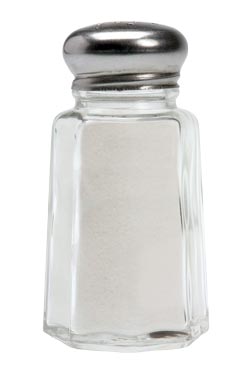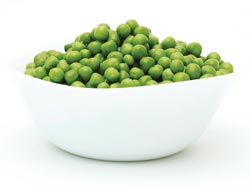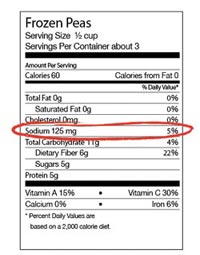

Caption: 77% processed and prepared foods, 12% Natural Sources, 6% Added while Eating, 5% Added while Cooking.
Source: Mattes, RD, Donnelly, D. Relative contributions of dietary sodium sources. Journal of the American College of Nutrition. 1991 Aug;10(4):383-393.
"A very modest decrease in the amount of salt...can have dramatic health benefits."
— Dr. Kirsten Bibbins-Domingo, U.Cal-SF
The salt in your shaker is actually the chemical compound sodium chloride. We can't live without it. Yet many studies show that too much is not good for our health. More than 90 percent of the salt we eat comes from our processed foods and prepared meals in restaurants or dining halls—not from the salt we sprinkle on our food.
"A very modest decrease in the amount of salt, hardly detectable in the taste of food, can have dramatic health benefits," says Dr. Kirsten Bibbins-Domingo, a researcher at the University of California, San Francisco. She led a recent NIH-funded study that found that lowering salt intake by only 3 grams (about half a teaspoon) could prevent as many as 92,000 deaths nationwide each year. There would be fewer than 120,000 new cases of heart disease. Strokes would be cut by 66,000; heart attacks by 100,000.
Although every segment of the population would benefit, African Americans would see the most improvement, because they are at greater risk of high blood pressure, also called hypertension. This is the force of blood pushing against artery walls as the heart pumps blood. Over time, hypertension can lead to heart disease, stroke, kidney failure, and other serious health problems.
Healthcare professionals concentrate on the effects of the sodium in salt. "The best known effect of sodium on health is the relationship between sodium and blood pressure," says Dr. Catherine Loria, of NIH's National Heart, Lung, and Blood Institute. Reducing salt intake lowers blood pressure. Almost one-third of American adults have high blood pressure and another 30 percent have pre-hypertension (blood pressure that is elevated but not high), Dr. Loria says, "It's really important for the majority of the population to reduce their blood pressure."
To help lower blood pressure, experts recommend that people consume fewer than 2,400 milligrams of sodium a day—about the amount found in a teaspoon of salt. People with high blood pressure should aim for 1,500 milligrams.
"Many people don't realize that a lot of our salt comes from breads and cereals," says researcher Bibbins-Domingo. She notes that more than 20 percent of the salt in the average American diet comes from breads, cereals, crackers, chips, and similar foods.
In view of this, NIH's Dr. Loria advises consumers to choose foods with less than five percent of the daily value of salt per serving. "Pay attention to nutrition facts on the labels. The percent daily value is a better guide than the language that's used on food labels like 'low-salt,'" she says.
Beyond lowering sodium intake, both experts urge that more people maintain a healthy diet, exercise regularly, lose weight, stop smoking, and take steps to avoid stress. That makes it far more likely they will lower their blood pressure and lead healthier lives.
Canned or Frozen: Which Has More Salt?
To find out, read the labels and compare.

Answer
Canned peas have three times more sodium than frozen peas.
Canned Peas Caption: Canned Peas, Serving Size ½ cup, Servings Per Container about 3, Amount Per Serving, Calories 60 Calories from Fat 0, % Daily Value*, Total Fat 0g 0%, Saturated Fat 0g 0%, Cholesterol 0mg 0%, Sodium 380 mg 16%, Total Carbohydrate 12g 4%, Dietary Fiber 3g 14%, Sugars 4g, Protein 4g, Vitamin A 6%, Vitamin C 10%, Calcium 2%, Iron 8%, * Percent Daily Values are, based on a 2,000 calorie diet.
Frozen Peas Caption: Frozen Peas, Serving Size ½ cup, Servings Per Container about 3, Amount Per Serving Calories 60 Calories from Fat 0%, Daily Value*, Total Fat 0g 0%, Saturated Fat 0g 0%, Cholesterol 0mg 0%, Sodium 125 mg 5%, Total Carbohydrate 11g 4%, Dietary Fiber 6g 22%, Sugars 5g, Protein 5g, Vitamin A 15%, Vitamin C 30%, Calcium 0%, Iron 6%, * Percent Daily Values are based on a 2,000 calorie diet.


